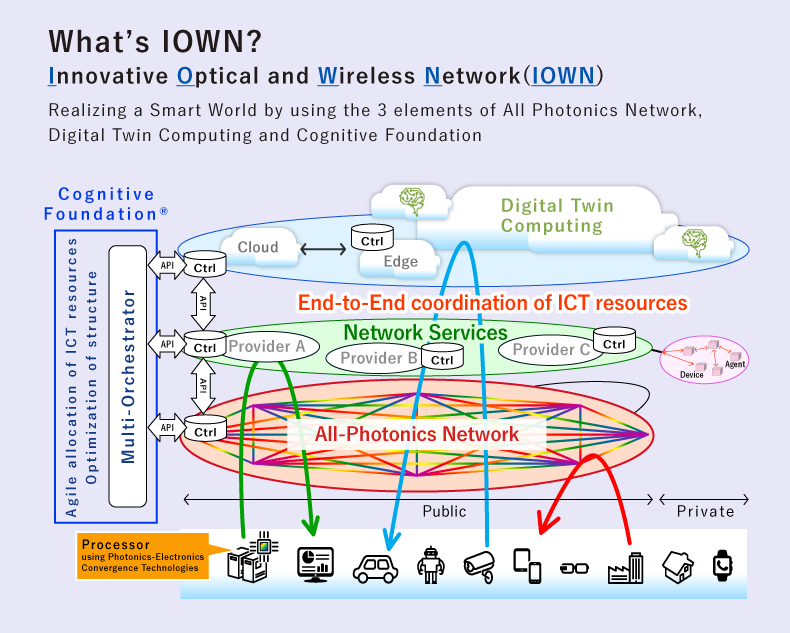Hello dear Getquin Community,
After $ORCL (-4.75%) Oracle caused quite a stir after the last quarterly figures and the market reacted extremely positively with a 40 percent increase in the share price, so much so that CEO Larry Ellison briefly became the richest person in the world overnight, I wanted to unravel the magic and find out exactly which division caused this tremor.
The answer is Cloud Infrastructure, or OCI for short. In this area, the demand for data centers for artificial intelligence has exploded, which has brought Oracle long-term orders worth 455 billion US dollars. However, it is not only Oracle that is benefiting, but also other hyperscalers, regional challengers and, above all, the so-called shovel manufacturers that provide the basic infrastructure.
I have taken the trouble to look for potential competitors and up-and-coming challengers so that you have a complete overview of this sector. I have divided the whole thing into the following segments: 🌍 Big players (hyperscalers), 💡 Hidden champions (selection by region), ⚒️ Shovel manufacturers (infrastructure suppliers) and, as always, my favorite.
If I have overlooked any important aspects or a classification was not entirely precise, I look forward to your comments and exciting additions. Together we can understand this topic even better and learn from each other.
Feel free to leave a 👍. I wish you every success with your investments 🚀
🌍 Big Player (Hyperscaler)
Amazon Web Services - $AMZN (-2.35%) (USA, Nasdaq) → World market leader with >30 % market share, huge data centers & own AI chips (Trainium, Inferentia)
Microsoft Azure - $MSFT (-0.32%) (USA, Nasdaq) → second largest provider, strong AI focus through OpenAI partnership
Google Cloud - $GOOGL (-3.46%) (USA, Nasdaq) → third largest provider, specialized in AI workloads & big data
Oracle Cloud Infrastructure (OCI) - $ORCL (-4.75%) (USA, NYSE) → Number 4 worldwide, currently fastest growth (+70-80 %), RPO USD 455 bn
Alibaba Cloud - $BABA (-0.9%) , $9988 (-0.52%) (China, NYSE/HKEX) → Market leader in Asia, complete cloud suite from IaaS to AI
Favorite: Oracle - $ORCL (-4.75%)
Oracle impresses with its cloud infrastructure OCI, which recently collected orders worth 455 billion US dollars. The moat lies in the close integration of the database business and cloud services as well as the multi-cloud partnerships with Microsoft and Google. The compounder property is the result of long-term contracts and economies of scale in data center construction.
Alternative favorite: Alibaba Cloud - $BABA (-0.9%) , $9988 (-0.52%)
Alibaba is number one in Asia and number four worldwide. The moat lies in the close integration with Alibaba's e-commerce and fintech ecosystem. The compounder property stems from the enormous growth in emerging markets and the increasing demand for cloud services in China. While the stock is valued significantly cheaper than Oracle, there are geopolitical and regulatory risks.
💡 Hidden champions (selection by region)
🇪🇺 Europe
OVHcloud - $OVH (-0.32%) PA (France) → largest European cloud provider, GDPR- and Gaia-X-focused
Scaleway - private (France, part of the Iliad Group) → Developer and AI cloud platform
T-Systems - part of $DTE (-0.8%) DE (Deutsche Telekom, Germany) → Hybrid & Sovereign Cloud for Public Sector
IONOS - $IOS (+1.26%) DE (Germany, Xetra)
Largest European web hosting and SME cloud provider. Burggraben: strong brand and high customer loyalty in the SME sector.
Aruba Cloud - private (Italy) → regionally strong in SMEs & hosting
Outscale - private (France, subsidiary of Dassault $DSY.PA) → Industrial Cloud & Simulation
Favorite: OVHcloud - $OVH (-0.32%)
Burggraben: strong position as a GDPR-compliant sovereign cloud with Gaia-X. Compounder: increasing trust from authorities and companies ensures growing recurring revenues.
🇨🇳 China
Baidu AI Cloud - part of $BIDU (-2.47%) , $9888 (-2.56%) (Nasdaq, China/USA) → AI workloads, autonomous driving, language models
JD Cloud - part of $JD (-0.3%) , $9618 (-0.36%) (Nasdaq, China/USA) → Cloud for e-commerce & retail
Kingsoft Cloud - $KC (+0.78%) , $3896 (+1.18%) (Nasdaq, China/USA) → Gaming, streaming and app cloud
China Telecom Cloud - part of $728 HK (HKEX) → Infrastructure cloud, state-supported
China Mobile Cloud - part of $941 HK (HKEX) → 5G edge cloud with telecom backbone
Favorite: Kingsoft Cloud - $KC (+0.78%) , $3896 (+1.18%)
Moat: Specializing in gaming, streaming and mobile apps with deep integrations into ecosystems. Compounder: benefits from China's growing online consumption and strong embedding in the Tencent environment.
🇯🇵 Japan
NTT Communications - part of $9432 (+0.06%) T (Tokyo) → Enterprise cloud with global network
NEC Cloud - $6701 (-1.24%) T (Tokyo) → Government & security solutions
Fujitsu Cloud K5 - $6702 (+1.15%) T (Tokyo) → Hybrid cloud for large companies
Rakuten Symphony Cloud - part of $4755 (-0.13%) T (Tokyo) → 5G & telecom cloud
IIJ Cloud - $3774 (-2.24%) T (Tokyo) → Cloud pioneer for enterprise IT
Favorite: NTT - $9432 (+0.06%)
Moat: global telecom backbone and huge enterprise customer base. Compounder: expansion of data centers in Asia and Europe with stable recurring revenues.
🇮🇳 India
Reliance Jio Cloud - part of $RELIANCE NS (NSE India) → Telecom Cloud, partnership with Azure
Tata Communications IZO - $TATACOMM NS (NSE India) → Hybrid cloud & global backbone
Infosys Cobalt - $INFY (NYSE/NSE India) → Cloud migration platform & consulting
HCLTech Cloud - $HCLTECH NS (NSE India) → AI-powered hybrid cloud
Wipro Cloud Studio - $WIPRO NS (NSE India) → MultiCloud service provider
Favorite: Tata Communications - $TATACOMM
Moat: global fiber optic network and deep networking in hybrid cloud. Compounder: growing international expansion and increasing demand for multi-cloud solutions.
🌏 Asia / Oceania
Naver Cloud - part of $035420 KQ (Korea KOSDAQ) → AI & gaming cloud
Samsung SDS Cloud - $018260 , $SMSN (-1.62%) KQ (Korea KOSDAQ) → Enterprise & IoT Cloud
KT Cloud - part of $030200 KQ (Korea KOSDAQ) → Telecom & Edge Cloud with 5G
Telstra Cloud - $TLS (-1.45%) AX (Australia) → Telecom Cloud, Asia-Pacific focus
Macquarie Telecom Cloud - $MAQ AX (Australia) → Public Sector & Compliance
Favorite: Naver Cloud - $035420
Moat: strong integration of AI and gaming in Korea. Compounder: rapid scaling due to growing demand for AI and ML applications.
🌍 Latin America
UOL Diveo (Compasso UOL) - private (Brazil) → Cloud + Managed Services
Tivit Cloud - private (Brazil) → MultiCloud for industry & banks
Locaweb Cloud - $LWSA3 SA (Brazil) → SME Hosting & Cloud
Claro Cloud - part of $AMX (-0.55%) (Mexico, NYSE/HKEX) → Telecom Cloud in Latin America
DesireCloud - private (Chile/Peru) → Local provider for companies
Favorite: Locaweb - $LWSA3
moat: Market leader for SME cloud and hosting in Brazil. Compounder: enormous scalability through the digitalization of small and medium-sized enterprises throughout Latin America.
🇨🇦 Canada
OVHcloud Canada - part of $OVH (-0.32%) PA (France) → Data centers for North America
SherWeb - private (Quebec) → Cloud and MSP services for SMEs
HostPapa - private (Canada) → SME cloud solutions
Canadian Web Hosting - private (Canada) → Cloud & hosting with a focus on data protection
Beanfield Cloud - private (Toronto) → Cloud combined with fiber optic infrastructure
Favorite: SherWeb - private
Moat: close ties to SMEs via managed services. Compounder: fast-growing cloud ecosystem for small businesses in North America, high customer loyalty.
⚒️ Blade manufacturers (infrastructure suppliers)
🖥️ Semiconductors & Chips
Nvidia - $NVDA (-3.26%) (USA, Nasdaq) → GPUs for AI training & cloud
AMD - $AMD (-4.68%) (USA, Nasdaq) → CPUs/GPUs for Data Center
Intel - $INTC (-4.8%) (USA, Nasdaq) → Server CPUs & AI accelerators (Gaudi)
TSMC - $TSM (-4.23%) (Taiwan, NYSE/TWSE) → largest chip manufacturer, produces for NVIDIA/AMD
Samsung Electronics - $SMSN (-1.62%) KQ (Korea) → Memory, foundry, GPUs/CPUs
Favorite: Nvidia - $NVDA (-3.26%)
Moat: near monopoly in high-end GPUs for AI. Compounder: Ecosystem and network effects through CUDA and developer community.
📦 Data center hardware & servers
Supermicro - $SMCI (-6.61%) (USA, Nasdaq) → GPU clusters & AI servers
Dell Technologies - $DELL (-6.71%) (USA, NYSE) → Enterprise Servers & Storage
Hewlett Packard Enterprise - $HPE (-5.2%) (USA, NYSE) → Hybrid Cloud & Edge
Inspur - private (China) → AI & Cloud Server
Lenovo - $LNVGY (+0.96%) (China/ADR) → HPC and AI servers
Favorite: Supermicro - $SMCI (-6.61%)
Moat: Specialization in GPU clusters and AI servers. Compounder: benefits from every expansion of the hyperscalers, extremely high scalability.
⚡ Memory & network chips
Micron - $MU (-7.24%) (USA, Nasdaq) → DRAM & HBM memory
SK Hynix - $HY9H (-4.1%) KQ (Korea) → Memory chips, HBM for NVIDIA
Broadcom - $AVGO (-14.32%) (USA, Nasdaq) → Network Chips & Switches
Marvell - $MRVL (-5.92%) (USA, Nasdaq) → Network & 5G chips
ASE Technology - $ASX (-4.29%) (Taiwan, NYSE) → Packaging for high-end chips
Favorite: Broadcom - $AVGO (-14.32%)
Moat: deep roots in network infrastructure of hyperscalers. Compounder: benefits from rising demand for switches and custom chips for the cloud.
🏭 Data centers / colocation
Equinix - $EQIX (-0.76%) (USA, Nasdaq) → largest colocation provider worldwide
Digital Realty - $DLR (-3.29%) (USA, NYSE) → Data centers worldwide, strong in Europe/USA
China Telecom DC - part of $728 HK (HKEX) → Data center infrastructure in China
NTT Data Centers - part of $9432 (+0.06%) T (Tokyo) → Data centers in Asia/Europe
NEXTDC - $NXT (-1.62%) AX (Australia) → Growing data centers in the APAC region
Favorite: Equinix - $EQIX (-0.76%)
Moat: global networking and extremely high switching costs for customers. Compounder: continuous expansion and cross-selling potential through platform structure.
🔋 Energy & cooling
Schneider Electric - $SU (-1.35%) PA (France, Euronext) → Power & Cooling for Data Center
ABB - $ABBN (-1.06%) (Switzerland, SIX/NYSE ADR) → Energy & Automation
Siemens Energy - $ENR (-3.96%) (Germany, Xetra) → Power Grids & Data Center Technology
Vertiv - $VRT (-10.05%) (USA, NYSE) → Cooling, Racks & UPSs
Eaton - $ETN (-5.21%) (Ireland/USA, NYSE) → Power Management
Favorite: Schneider Electric - $SU (-1.35%)
Burggraben: market-leading energy and cooling systems for data centers. Compounder: long-term growth due to increasing demand for efficient data centers.
🌐 Network & Connectivity
Cisco - $CSCO (-2.24%) (USA, Nasdaq) → Router & Network Hardware
Arista Networks - $ANET (-7.57%) (USA, NYSE) → High-speed switches for hyperscalers
Juniper Networks - Acquisition by $HPE (-5.2%) Hewlett Packard HP (USA, NYSE) → Routing & Network Security
Ciena - $CIEN (-9.48%) (USA, NYSE) → Fiber Optics & Optical Networks
Nokia - $NOK (-0.93%) (Finland, NYSE/Helsinki) → 5G & Core Networks
Favorite: Arista Networks - $ANET (-7.57%)
Moat: technological leadership in high-speed switches in hyperscaler data centers. Compounder: enormous growth opportunities due to exponential data traffic in AI workloads.
✨ Takeaway
The Oracle quake shows: Cloud & AI are the growth drivers of the coming years. While hyperscalers are in the spotlight, hidden champions are growing in their niches in the background and blade manufacturers are making money from every expansion of the infrastructure.
👉 Question for you: Do you prefer to focus on hyperscalers in your strategy? hyperscalersthe hidden champions or directly on the shovel manufacturers?
I look forward to your opinions!
Source: own analysis
Image - Image credit: Getty Images







